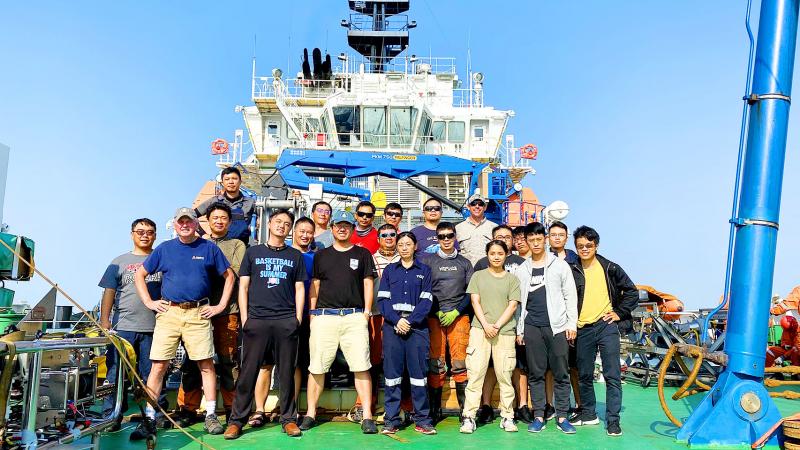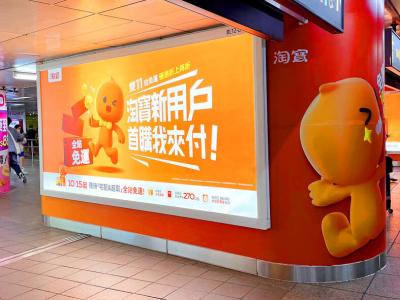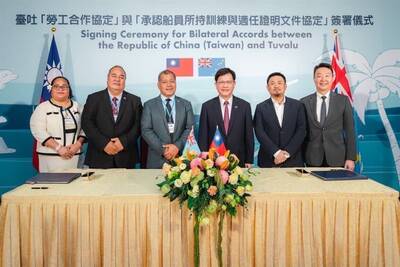A team of Taiwanese and US researchers last month overcame challenges from the COVID-19 pandemic and rough seas to complete an underwater sound survey near the South China Sea.
The expedition from Oct. 14 to 19 aboard the research vessel Legend, operated by the Taiwan Ocean Research Institute (TORI), set out to investigate undersea sound propagation in relation to internal waves and shelf breaks, said Lin Ying-Tsong (林穎聰), a Taiwanese-American scientist with the Woods Hole Oceanographic Institution (WHOI) in Massachusetts.
The area is an optimal region for conducting this experiment, where the vertical displacement of internal waves can reach more than 100m, the largest in all oceans, he said.

Photo courtesy of Lin Ying-Tsong, Woods Hole Oceanographic Institution associate scientist
For the cruise, researchers transported more than 8 tonnes of instruments from the WHOI to Kaohsiung, with air and sea freights totaling US$650,000, while they also used some instruments from local partners led by National Sun Yat-sen University (NSYSU) associate professor Chiu Yung-Sheng (邱永盛), Lin said.
The international collaboration between the university and WHOI is funded by the Ministry of Science and Technology and the US Office of Naval Research, he said.
Lin in June became the 12th person, and the first of Asian descent, to dive to the Earth’s deepest part, the Challenger Deep in the Mariana Trench, together with US adventurer Victor Vescovo in a submarine.
Arriving with Lin last month were WHOI Mooring Operations and Engineering Group lead John Kemp and WHOI research engineer Peter Koski, who have worked in the field for 42 and 21 years respectively.
Because of rough sea conditions during the endeavor, researchers had to conduct some experiments at contingency sites, but were still able to deploy and recover their instruments along with the data, Kemp said on Oct. 21, two days before he left Taiwan.
While at sea, a military charter flight from Kaohsiung to the Pratas Islands (Dongsha Islands, 東沙群島) on Oct. 15 was denied entry by Hong Kong authorities, which cited “dangerous activities” in the area, although the Ministry of National Defense said that there was no Chinese military drill or other abnormal situations.
Asked if they had encountered any interference, Kemp said they had not, but they saw from a distance a Taiwanese navy vessel and another ship, which some said might have come from China.
Other than the weather, it was a smooth trip, he said.
“We’re here for research, not for military reasons,” he said.
Kemp first visited Taiwan in 1999 in preparation for the Asian Seas International Acoustics Experiment, an international and multi-vessel project, and returned in 2000, 2010 and 2011 for other missions prior to this trip, he said.
“I got to make some really good friends here,” he said. “Taiwan has the nicest people on the planet.”
Safety is his No. 1 priority when working on deck, and the other part of his job is to train people, Kemp said.
“If you share knowledge, you build up mutual friendships and get good science done much easier,” he said.
While the US is more advanced in oceanographic technology, Kemp said that he sees in Taiwanese the passion for ocean science and the ambition to learn more.
“There are so many interesting things in the South China Sea that people haven’t researched very much,” he said.
The WHOI works globally and could work with Taiwanese in other areas, including the Arctic or Antarctica, as long as there are common goals, he said.
National Taiwan University Institute of Oceanography technician Her Wen-hwa (何文華), who did not join the cruise, but met with the US visitors later, described Kemp’s mooring skills as among the world’s best.
Deploying instruments is not just about dumping them into the water, but an art that requires a lot of planning, negotiations and quick responses to changes from all directions, Her said.
“Anyone can jump into the water, but not everyone can make graceful jumps,” he said.
Koski said that Taiwan is his favorite travel destination and that he has since 2017 visited Taiwan every year for research.
A research engineer of WHOI’s Acoustic Communication Group, Koski said the group is focused on underwater wireless communications and the development of new techniques and instruments.
Asked if autonomous underwater vehicles would become more important than ship-based surveys, he said the vehicles are certainly critical in studying the ocean environment, but not necessarily more important than other tools, as a broad range of capabilities are required for achieving certain scientific or engineering goals.
“There are always financial decisions to be made, and sometimes autonomous techniques can be more cost effective compared to ships. Ultimately, resources in all forms are limited, so efficiency is important,” he said.
Asked about the relationship between engineers and scientists aboard a research ship, Koski said that it is a team environment where everyone plays their part or parts to accomplish the research goals.
Scientists might be the ones who have the initial curiosity about a subject, and engineers are motivated to improve technology and ship capabilities, but when it comes to safety, the ship crew would be the ones who take the lead, he said.
Regarding his impression of working with Legend’s captain, Huang Chiu-Hsing (黃久倖) — the nation’s first female captain of a research ship — Koski said that there is no difference between male and female captains from a professional perspective, adding: “It’s part of normal life.”
It was the first time that the Legend was employed by a foreign team after the vessel was inaugurated in 2018, TORI director Wang Chau-Chang (王兆璋) said.
Despite the rough seas, the team was able to accomplish their task, and they praised TORI personnel for skill in operating the top-notch research ship and assisting with experiments, he said.
Meeting the US visitors after the cruise, Wang said he hoped that both sides would have more collaborations, in areas such as deploying air-sea observation instruments, conducting seabed surveys and developing ocean bottom seismometers.
Staying longer in Taiwan than his US colleagues after the project, Lin also met with several officials, diplomats and academics, in the hope of encouraging more Taiwan-US collaborations in oceanography.

The Ministry of Economic Affairs has fined Taobao NT$1.2 million (US$36,912) for advertisements that exceed its approved business scope, requiring the Chinese e-commerce platform to make corrections in the first half of this year or its license may be revoked. Lawmakers have called for stricter enforcement of Chinese e-commerce platforms and measures to prevent China from laundering its goods through Taiwan in response to US President Donald Trump’s heavy tariffs on China. The Legislative Yuan’s Finance Committee met today to discuss policies to prevent China from dumping goods in Taiwan, inviting government agencies to report. Democratic Progressive Party Legislator Kuo Kuo-wen (郭國文) said

The Ministry of Economic Affairs has fined Taobao NT$1.2 million (US$36,900) for advertisements that exceeded its approved business scope and ordered the Chinese e-commerce platform to make corrections in the first half of this year or its license would be revoked. Lawmakers have called for stricter supervision of Chinese e-commerce platforms and more stringent measures to prevent China from laundering its goods through Taiwan as US President Donald Trump’s administration cracks down on origin laundering. The legislature’s Finance Committee yesterday met to discuss policies to prevent China from dumping goods in Taiwan, inviting government agencies to report on the matter. Democratic Progressive Party

Taiwan and its Pacific ally Tuvalu on Tuesday signed two accords aimed at facilitating bilateral cooperation on labor affairs, according to Taiwan’s Ministry of Foreign Affairs (MOFA). The governments inked two agreements in Taipei, witnessed by Foreign Minister Lin Chia-lung (林佳龍) and visiting Deputy Tuvaluan Prime Minister Panapasi Nelesone, MOFA said in a news release. According to MOFA, the agreements will facilitate cooperation on labor issues and allow the two sides to mutually recognize seafarers’ certificates and related training. Taiwan would also continue to collaborate with Tuvalu across various fields to promote economic prosperity as well as the well-being of their

Sung Chien-liang (宋建樑), who led efforts to recall Democratic Progressive Party (DPP) Legislator Lee Kun-cheng (李坤城), was released on bail of NT$80,000 today amid outcry over his decision to wear a Nazi armband to questioning the night before. Sung arrived at the New Taipei District Prosecutors’ Office for questioning in a recall petition forgery case last night wearing a red armband bearing a swastika, carrying a copy of Adolf Hitler’s Mein Kampf and giving a Nazi salute. Sung left the building at 1:15am without the armband and covering the book with his coat. Lee said today that this is a serious